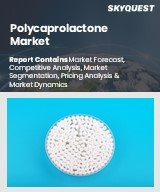
세계의 폴리카프로락톤 시장 규모는 2023년에 6억 1,830만 달러로 평가되며, 2024년 6억 7,704만 달러에서 2032년까지는 13억 9,935만 달러로 성장하며, 예측 기간(2025-2032년)의 CAGR은 9.5%로 성장할 전망입니다.
세계의 폴리카프로락톤(PCL) 시장은 섬유, 자동차, 생물의학 등 다양한 산업 분야에서 다용도한 용도로 인해 큰 성장 잠재력을 보여주고 있습니다. 생분해성 소재에 대한 수요 증가는 특히 지속가능한 제품 개발에서 PCL의 매력을 높이고 있습니다. 친환경 대체 소재에 대한 관심이 높아지면서 3D 프린팅, 접착제, 약물전달 시스템 등의 분야에서 PCL의 채택이 증가하고 있습니다. 주요 기업은 이러한 수요 증가에 대응하기 위해 혁신적인 제조 공정에 초점을 맞추고 제품 포트폴리오를 확장하고 있습니다. 또한 기술 발전으로 특성이 개선된 고성능 PCL의 생산이 가능해지면서 더 많은 투자가 이루어지고 있습니다. 전반적으로 시장 역학은 지속가능성과 혁신에 초점을 맞추고 미래의 궤도를 형성하는 시장 상황이 유망하다는 것을 보여줍니다.
Global Polycaprolactone Market size was valued at USD 618.3 million in 2023 and is poised to grow from USD 677.04 million in 2024 to USD 1399.35 million by 2032, growing at a CAGR of 9.5% during the forecast period (2025-2032).
The global Polycaprolactone (PCL) market showcases significant growth potential, driven by its versatile applications across various industries such as textiles, automotive, and biomedical sectors. Increasing demand for biodegradable materials has bolstered PCL's appeal, particularly in sustainable product development. The rising trend toward eco-friendly alternatives is enhancing its adoption in applications like 3D printing, adhesives, and drug delivery systems. Key players are focusing on innovative manufacturing processes and expanding their product portfolios to capitalize on this growing demand. Moreover, advancements in technology are enabling the production of high-performance PCL with improved properties, attracting further investment. Overall, the market dynamics indicate a promising landscape for Polycaprolactone, with a strong emphasis on sustainability and innovation shaping its future trajectory.
Top-down and bottom-up approaches were used to estimate and validate the size of the Global Polycaprolactone market and to estimate the size of various other dependent submarkets. The research methodology used to estimate the market size includes the following details: The key players in the market were identified through secondary research, and their market shares in the respective regions were determined through primary and secondary research. This entire procedure includes the study of the annual and financial reports of the top market players and extensive interviews for key insights from industry leaders such as CEOs, VPs, directors, and marketing executives. All percentage shares split, and breakdowns were determined using secondary sources and verified through Primary sources. All possible parameters that affect the markets covered in this research study have been accounted for, viewed in extensive detail, verified through primary research, and analyzed to get the final quantitative and qualitative data.
Global Polycaprolactone Market Segments Analysis
Global Polycaprolactone Market is segmented by Form, Production Method, Grade, Application and region. Based on Form, the market is segmented into Pellets, Nanosphere and Microsphere. Based on Production Method, the market is segmented into Ring Opening Polymerization and Polycondensation of Carboxylic Acid. Based on Grade, the market is segmented into High Molecular Weight PCL and Low Molecular Weight PCL. Based on Application, the market is segmented into Drug Delivery Systems, Tissue Engineering, Biodegradable Packaging, 3D Printing and Coatings and Adhesives. Based on region, the market is segmented into North America, Europe, Asia Pacific, Latin America and Middle East & Africa.
Driver of the Global Polycaprolactone Market
The global market for polycaprolactone (PCL) is experiencing significant growth due to the rising awareness of environmental issues and increasing regulations concerning plastic waste. Industries are increasingly adopting biodegradable polymers like PCL, which are seen as sustainable alternatives to conventional petroleum-based plastics. This shift is driven by a commitment to eco-friendly practices, propelling PCL's utilization in various sectors, including green manufacturing, 3D printing, and sustainable packaging solutions. As both governments and corporations prioritize the transition to biodegradable materials, the demand for PCL continues to expand, positioning it as a key component in the effort to reduce plastic pollution.
Restraints in the Global Polycaprolactone Market
The global Polycaprolactone (PCL) market faces challenges due to the intricate production processes associated with its manufacturing and the dependence on specific raw materials, leading to elevated production costs. This financial aspect significantly restricts its usability, especially in price-sensitive applications. Furthermore, conventional plastics pose competition by offering more economical solutions, thereby inhibiting the widespread adoption of PCL products. Despite the ongoing development of more affordable alternatives, PCL struggles to compete in both cost and scalability, which limits its overall market potential and adoption across various industries.
Market Trends of the Global Polycaprolactone Market
The global polycaprolactone (PCL) market is witnessing significant growth driven by an escalating demand for sustainable and biodegradable polymers across various sectors, including medical, packaging, and consumer goods. As environmental awareness intensifies, companies are increasingly adopting PCL due to its eco-friendly properties, catalyzing research into innovative, bio-based production methods that reduce reliance on fossil fuels. This trend is reinforced by supportive policies promoting green materials and sustainability initiatives, positioning PCL as a vital component in the transition towards more sustainable manufacturing practices. As businesses prioritize environmentally conscious solutions, the PCL market is expected to expand, reflecting a broader market shift toward sustainability.